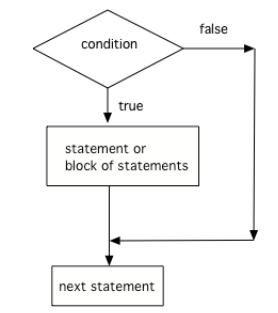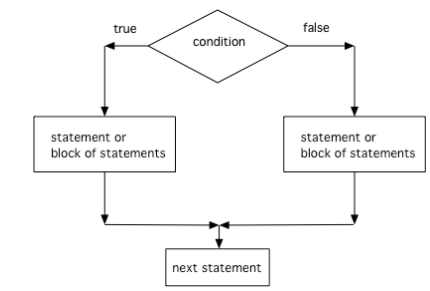📓2.3: if Statements
Table of Contents
📖 This page is a condensed version of CSAwesome Topic 2.3
One-Way Selection: if
If statements (also called conditionals or conditional blocks) are found in all programming languages as a way to choose between different paths in an algorithm. An if statement is a type of selection structure that interrupts the usual sequential execution. It affects the program’s flow of control by executing different segments of code based on the value of a boolean expression (also called the condition).
ifthe condition istrue, then the next statement (or block of statements) will execute.ifthe condition isfalse, then the next statement (or block of statements) is skipped.

Syntax of an if Statement
An if statement begins with the keyword if followed by a boolean expression (condition) inside of an open parenthesis ( and a close parenthesis ) and then followed on the next line by either a single statement, or a block of statements. The open curly brace { and a close curly brace } are used to group a block of statements together.
✋ Examples of if statements for one-way selection:
// Single if statement → body indented
if (boolean expression)
statement;
// Single if statement → body in {}
if (boolean expression) {
statement;
}
// Block if statement → {} REQUIRED!
if (boolean expression) {
statement1;
statement2;
...
statementN;
}
Note that there is no semicolon (
;) at the end of the boolean expression (condition) in an if statement, because it is not the end of an instruction. Curly braces ({ }) are used to mark the beginning and end of the conditional’s body, the block of code that’s dependent on the condition.
Consider the example below. Imagine that your cell phone wanted to remind you to take an umbrella if it was currently raining in your area when it detected that you were leaving the house:
boolean isRaining = true;
if (isRaining) {
System.out.println("Take an umbrella! ☔️");
}
System.out.println("Drive carefully");
The variable
isRainingis a boolean variable that is eithertrueorfalse. If it is true then the messageTake an umbrella!will be printed and then execution will continue with the next statement which will printDrive carefully.
Relational Operators in Conditions
Most if statements have a boolean expression that uses relational operators like ==, !=, <, >, <=, >=, as we saw in the last lesson.
For example, (grade > 60.0) is a boolean expression (rather than just a boolean variable) and can be used to control the if statement:
double grade = 85.0;
if (grade > 60.0) {
System.out.println("Congrats, you passed!");
}
System.out.println("Summer school is always an option...");
A common mistake in if statements is using = instead of == in the condition. You should always use == in the condition of an if statement to test a variable. One equal sign (=) assigns a value to a variable, and two equal signs (==) test if a variable has a certain value.
Two-Way Selection: if-else
What if you want to pick between two possibilities?
🪙 If you are trying to decide between two things to do, you might flip a coin and do one thing if it lands as heads, and another if it is tails. This is an example of two-way selection.
A two-way selection involves two connected conditional blocks: an if statement controlled by a boolean expression (condition), followed by a corresponding else statement. The program executes the if body when the condition is true, and the else body when the condition is false.

Syntax of an if-else Block
🔀 If you want to decide between two possibilities, use a if statement followed by else:
// Block if-else
if (boolean expression) {
statement1;
statement2;
}
else {
otherStatement;
anotherStatement;
}
Note: an
elseblock does not specify a boolean expression/condition in parenthesis, because it is simply the alternative path to theifstatement it comes after.
Type the code below, press run, and then:
- Change
isHeadstofalse. - See what prints before
"after conditional".
boolean isHeads = true;
if (isHeads) {
System.out.println("Let's go to the game");
}
else {
System.out.println("Let's watch a movie");
}
System.out.println("after conditional");
Common Errors with Conditional Blocks
Here are some rules to follow with if statements to avoid some common errors:
-
Always use curly braces (
{and}) to enclose the block of statements under the if condition. Java doesn’t care if you indent the code—it goes by the{ }. -
Don’t put in a semicolon
;after the first line of the if statement,if (test);. Theifstatement is a multiline block of code that starts with theifcondition and then{the body of the if statement}. -
Always use
==, not=, in the condition of an if statement to test a variable. One=assigns, two==tests! -
The
elsestatement matches with the closestifstatement. If you want to match anelsewith a differentifstatement, you need to use curly braces to group theifandelsetogether.
Summary
-
(AP 2.3.A.1) Selection statements change the sequential execution of statements.
-
(AP 2.3.A.2) An if statement is a type of selection statement that affects the flow of control by executing different segments of code based on the value of a Boolean expression.
-
(AP 2.3.A.3) A one-way selection (if statement) is used when there is a segment of code to execute under a certain condition. In this case, the body is executed only when the Boolean expression is true.
-
if statements test a boolean expression and if it is true, go on to execute the body which is the following statement or block of statements surrounded by curly braces (
{}) like below.
if (boolean expression){
Do Statement1;
Do Statement2;
...
Do StatementN;
}
-
Relational operators (
==,!=,<,>,<=,>=) are used in boolean expressions to compare values and arithmetic expressions. - If statements can be followed by an associated else part to form a 2-way branch:
if (boolean expression){ Do statement; } else { Do other statement; } - (AP 2.3.A.4) A two-way selection (if-else statement) is used when there are two segments of code—one to be executed when the Boolean expression is true and another segment for when the Boolean expression is false. In this case, the body of the if is executed when the Boolean expression is true, and the body of the else is executed when the Boolean expression is false.
Acknowledgement
Content on this page is adapted from Runestone Academy - Barb Ericson, Beryl Hoffman, Peter Seibel.